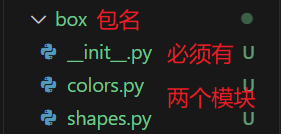python笔记:第十章开箱即用的模块
1.模块
import 模块名
1.1 模块就是程序
任何python程序都可以作为模块导入,并标明程序(模块)的位置
import sys
sys.path.append('路径')
import hello // 在同一文件夹下
会在该文件夹里面自动生成一个__pycache__ 文件夹,包含处理后的文件。(可删除,无影响)

在hello.py里面编写函数

在t13.py里面调用模块函数
import hello
hello.hello1()
运行结果
hello
hello!
1.2 模块属性
1.2.1 name
检查模块是作为程序运行还是被导入到另一个程序
如:在t13文件中,查看name属性
print(__name__)
> __main__
在t13文件中,查看hello文件的name属性
print(hello.__name__)
> __hello__
1.2.2 dir
查明模块包含哪些东西,列出对象的所有属性(函数,类,变量)
print(dir(模块名))
import box.shapes as sh
print(dir(sh))
['__builtins__', '__cached__', '__doc__', '__file__', '__loader__', '__name__', '__package__', '__spec__']
1.2.3 变量__all__
用于指定一个模块的所有公共接口(方法),只有被__all__指定的接口,才可以被正确导入。
module.py
__all__ = ['foo', 'bar']
def foo():
print("This is foo!")
def bar():
print("This is bar!")
def baz():
print("This is baz!")
main.py
from module import *
foo()
bar()
baz()
运行main.py结果
This is a foo!
This is bar!
NameError: name 'bar' is not defined
1.2.4 文档__doc__
查看模块信息和函数信息
print(range.__doc__)
range(start, stop[, step]) -> range object
Return an object that produces a sequence of integers from start (inclusive)
to stop (exclusive) by step. range(i, j) produces i, i+1, i+2, ..., j-1.
start defaults to 0, and stop is omitted! range(4) produces 0, 1, 2, 3.
These are exactly the valid indices for a list of 4 elements.
When step is given, it specifies the increment (or decrement).
自定义文档字符串
通过三引号的方式添加
def plus(a, b):
'''This is a plus'''
print(a + b)
print(plus.__doc__)
> This is a plus
1.2.4 获取模块路径__file__
可以获取当前模块所在的目录或文件的绝对路径。
如main.py
print(__file__)
> d:\M\github\Python\Demo\main.py
还可以使用os.path模块的方法对路径进行处理,例如获取当前模块所在目录的绝对路径:
import os
module_dir = os.path.dirname(os.path.abspath(__file__))
print(module_dir)
> d:\M\github\Python\Demo
2.包
包可以包含其他模块,模块存储在扩展名为.py的文件中,包则是一个目录。
包必须包含有__init__.py文件

在与文件夹box的同级文件下可以导入
import box
import box.shapes
3.一些重要的模块
3.1 sys
3.2 os
3.3 fileinput
3.4 集合,堆和双端队列
3.5 time
3.6 random
3.7 shelve和json
3.8 re
re,即正则表达式模块